#muroc dry lake
Explore tagged Tumblr posts
Photo
Taken at Muroc dry lake in 1938.

Model A Sport Coupe
35 notes
·
View notes
Text

20 August 1947. Major Marion E. Carl, USMC, left, and Commander Turner F. Caldwell, Jr., USN, stands with the record-setting Douglas D-558-I Skystreak, No. 37970, on Muroc Dry Lake.
@ron_eisele via X
104 notes
·
View notes
Text
Some days you're the hero
Some days you crash into muroc dry lake bed at 218mph.
Any one you walk away from i guess.
0 notes
Text
May 1936: Sightings and Snippets
May 3, 1936 – Detroit Free Press
That broken-down flivver that Carole Lombard presented to Clark Gable on Valentine’s Day has turned out to be the joy of his life. As a gag, Carole bought the oldest car she could find. She had it painted white and decorated with red hearts. Clark has become so sentimental over his gift that he drives it instead of his expensive new roadster. Of course, he has removed the decorations.
When Carole heard that he was actually driving the car to work every morning, she bought a lot of fancy accessories. The car originally cost Carole $65. To date, she has spent close to $200 on fixtures.
May 3, 1936 – St. Louis Globe Democrat
Something, folks are saying, is going to become of this palship between Clark Gable and Carole Lombard, who are seen together here, there, and everywhere.
May 12, 1936 – The Central New Jersey Home News
That Carole Lombard-Clark Gable romance seems to be warming up… now he’s going over to Paramount Studio to call for her when she finishes for the day in “The Princess Comes Across” …
May 18, 1936 - The Des Moines Tribune

Carole Lombard and Clark Gable saw a skating exhibition by Sonja Henie in Hollywood.
May 20, 1936 – The Charleston Daily Mail
The romance scouts are speculating on the temperature of Gable’s friendship with Carole Lombard. He has been meeting her at the Paramount gate every afternoon at 5.
May 27, 1936 – The Cushing Daily Citizen
The famous Valentine Ford that Carole Lombard gave to Clark Gable is undergoing a process of rejuvenation. Relegated for a while to Clark’s servants, it now is in the garage where a racing motor is being installed. Mechanics say it will be good for 115 miles an hour when delivered to the star, and speed-minded Clark will test this out on Muroc dry lake. He’ll do it as soon as he isn’t working with Marion Davies on the “Cain and Mabel” set.
May 28, 1936 – The Sacramento Bee
Snapshots of Hollywood, collected at random: Carole Lombard taking a busman’s holiday and visiting Marion Davies during the night filming of “Cain and Mabel;” Clark Gable trying to put one over on Carole, installing an expensive motor in the broken down Ford she gave him in order to race with her, but the engine was so heavy it fell out of the car, so the laugh is again on Clark.
0 notes
Text
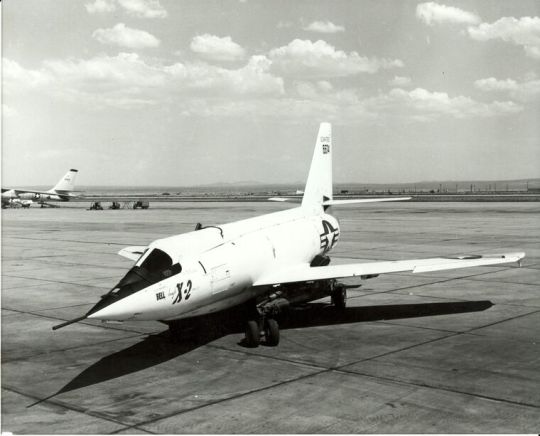
-A Bell X-2 at Edwards AFB. A Boeing B-47 is visible in the background. | Photo: NACA/USAF
FLIGHTLINE: 159 - BELL X-2 STARBURSTER
The X-2 was built to investigate the "thermal thicket" at speeds above Mach 2, but the two examples completed had a short service life.
Building on the work of the Bell X-1 and Douglas D-558 aircraft, the X-2 (nicknamed Starburster, though it was rarely used) was designed to explore speeds in excess of Mach 2. Engineer calculations, backed up by flights of the former aircraft, indicated the existence of a "thermal thicket"; that is: escalating aerodynamic heating as speeds increased. As a result, Bell devoted extensive time to development of advanced materials, aerodynamics, and control systems all with the goal of creating an aircraft capable of flying faster and higher than any human had done previously.

-Orthograph of the X-2. | Illustration: NASA-DFRC
The X-2 incorporated numerous advances over the X-1, including a swept wing and horizontal stabilizer. The airframe was built from K-Monel, an alloy of coper and nickel, as well as stainless steel. An XLR-25 two-chamber throttleable rocket motor provided 2,500 to 15,000 pounds of thrust, burning a mix of liquid oxygen and alcohol. The XLR-25, produced by Curtiss-Wright, was actually based on a WWII RATO bottle developed by Robert Goddard for the US Navy. The aircraft were designed with a skid rather than main landing wheels, though a nose gear was equipped, as well as skids on the wingtips.
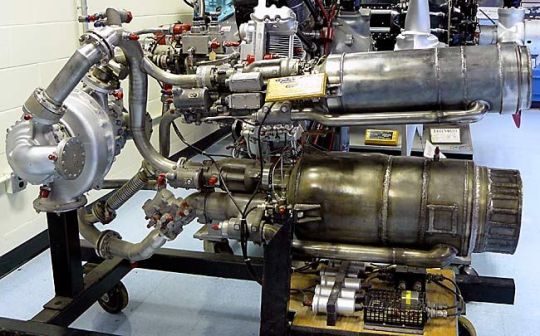
-An XLR-25 motor on display at the Aviation Hall of Fame in New Jersey. | Photo: Bill Maloney
In a worst-case scenario, the cockpit section of the X-2 could be ejected. With stability provided by a parachute, the pilot could then eject the canopy and bail out. Like the Skyrocket and X-1 before it, the X-2 would be carried aloft by a bomber (in this case a Boeing B-50), then dropped to begin its flight.

-One of the X-2s, its ground support personnel, the B-50 and its crew, F-86, F-80 and F-100 chase planes, and H-19 rescue helicopter. | Photo: NACA
FLIGHT TEST PROGRAM
X-2 number 1 was chosen to have the first engine installed, so ship #2 was sent to Edwards AFB for initial unpowered tests. The first glide test of the X-2 was on 27 June 1952, and ended rather inauspiciously. During the landing on Muroc dry lake bed, the aircraft pitched unexpectedly, forcing the right wingtip to contact the ground, breaking off the bumper. The nose gear collapsed as well, and the aircraft slid along the lakebed on its fuselage for some distance before coming to rest. The second flight was delayed while repairs were completed, and took place on 8 October, followed by the third flight two days later.
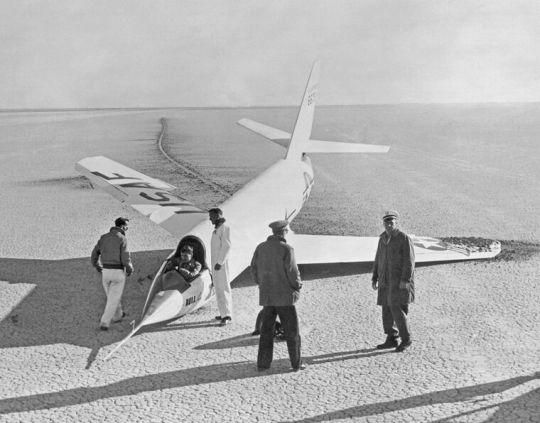
-Bell test pilot Jean Ziegler sits in the cockpit of the damaged X-2 #2 after the 1st rough landing. | Photo: NACA
X-2 number 2 was returned to Bell's factory in New York state afterwards, and the XLR-25 engine was installed. A captive carry flight over Lake Ontario on 12 May 1953 resulted in the loss of aircraft #2, Ziegler, and Frank Wolko from the B-50 crew. During a test of the liquid oxygen system, an explosion rocked the combined aircraft, jettisoning the Starburster, Ziegler and Wolko. The remains of the X-2 fell into Lake Ontario, and neither it, nor the bodies of the two men were recovered. The B-50 mother ship was able to return to the Bell facility, but was judged to be uneconomical to repair, and was scrapped. Similar explosions destroyed one of the X-1s, the X-1A and X-1D, and were eventually traced to Ulmer leather gaskets in the fuel system. The gaskets, treated with tricresyl phosphate (TCP), would react with liquid oxygen, making them explosive if sufficiently jarred. The Ulmer leather gaskets were replaced, and the explosions stopped.

-A Bell X-2 is loaded aboard the Boeing B-50A-5-BO Superfortress “mothership,” 46-011. | Photo: USAF
Modifications to the first X-2 and the engine delayed flights until 1955, with the first powered flight occurring on 18 November, reaching a speed of Mach 0.95. The test series began in earnest at this point, with the Starburster showing both its promise but also its limitations. On his final flight in July 1956, Lt. Col. Pete Everest was propelled to Mach 2.87, earning him (temporarily at least) the title of "Fastest Man Alive". Everest reported that the controls were only marginally effective at those speeds however, as the center of pressure for the aircraft changed at high speed, coupled with aeroelasticity of the empennage rendered the flight surfaces ineffective.

-Photo of the first X-2, showing shock diamonds in both exhaust plumes. | Photo: NACA
Testing continued however, with Captain Iven Kincheloe crossing 100,000 for the first time on 7 September 1956 and Captain Milburn Apt setting a new (unofficial) speed record of Mach 3.2. This mark came a grave cost however, as Apt, likely the victim of a lagging or miscalibrated instrument, attempted a banked turn above Mach 3, far in excess of what the X-2 could achieve. The aircraft tumbled out of control, with Apt unable to counter the control coupling, inertial roll coupling and supersonic spinning faced by the aircraft. Apt triggered the ejection of the nose, but was incapacitated by the forces he encountered, and was unable to release the canopy and free himself to activate his own parachute, and was killed when the capsule struck the lakebed. The nose-less X-2 continued on, eventually returning to Earth with little damage. A proposal was made to salvage the plane and modify it for hypersonic research, but was not funded, and the first X-2 was scrapped.

-Color photo of an X-2 still coupled to the B-50D mothership prior to launch. | Photo: USAF
LEGACY
The two X-2s completed 20 flights between 1952 and 1956, and although they set records in both altitude and speed, their contribution to the knowledge of high speed aerodynamics and heating was debatable. The unmanned X-7 and research variants of the Bomarc missile were capable of the same speeds, and the destruction of both X-2s meant that much of NACA's planned test program was left unflown. Manned exploration of hypersonic speeds and ultra-high altitudes would have to wait for the North American X-15, still several years off.
The X-2 was made a part of the 1956 film "Toward the Unknown", as the movie depicts several real and fictional test programs taking place at the USAF Flight Test Center at Edwards AFB. The climax of the movie depicts and accident roughly similar to Mel Apt's, although the pilot survives the crash.
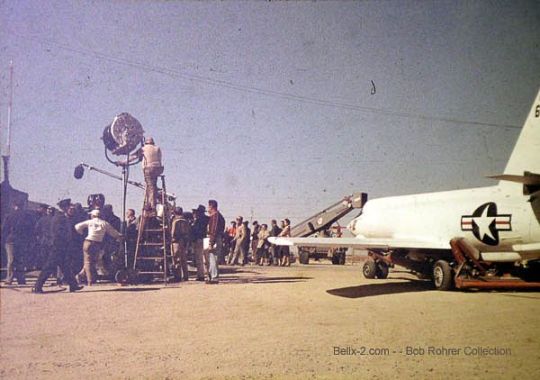
-Film crews surround the X-2 during filming for Toward the Unknown. | Photo: Bob Rohrer
The plane was later included in the pilot movie "Genesis" for the NBC series "Quantum Leap", in which the main character time travels into the body of a fictional pilot for the aircraft. A full-scale mockup of the X-2 was created for the show, and was later acquired by the Planes of Fame Museum in California. The prop is still in the museum's collection, though years of exposure have not been kind to the faux-X plane, which was not built to last in the first place.
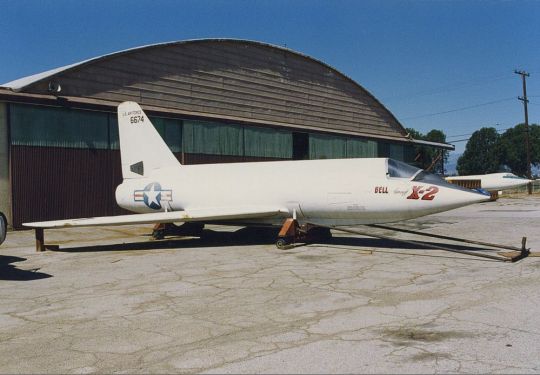
-Photo of the X-2 mockup at the Planes of Fame Museum in Chino, CA, some time in 1994. | Photo: Jon Goto
#aircraft#aviation#avgeek#airplanes#cold war#airplane#cold war history#coldwar#usaf#aviation history#naca#nasa#nasa history#edwards air force base#muroc dry lake#dryden flight research center#bell aircraft#x2#x 2#research aircraft#xplane#x plane
127 notes
·
View notes
Text



Chopped coupes at the lakes, 1938-'41.
26 notes
·
View notes
Text
B-47, modified B-58 (might be Snoopy, which tested the radar for the YF-12) and a LLRV.

#edwards afb#muroc dry lake#California#usaf#nasa#the 1960s#1960s#60s#the 60s#the sixties#cold war history#coldwar#cold war#apollo#boeing b 47#b 47#b 58 hustler#b58 hustler#convair b58#b58#b47
44 notes
·
View notes
Photo

A Douglas Skyrocket flies over Muroc Dry Lake, California, November 1949. (Muroc Army Airfield later became Edwards AFB.)
(USC Digital Library)
#skyrocket#aviation#history#space#vintage#1949#1940s#edwards afb#edwards air force base#muroc dry lake#california#desert#rogers dry lake
170 notes
·
View notes
Text

On this day: 75 years ago, company test pilot George S. “Wheaties” Welch, made the maiden flight of the North American F-86 Sabre at Muroc Dry Lake, California (October 1, 1947). One of the greatest jet fighter designs of all time, was born.
107 notes
·
View notes
Photo

Dale's Wheels Through Time
“The Fred Ham Special”This 1937 Harley Davidson EL Knucklehead is an exact recreation of the motorcycle Fred “Ironman” Ham road to a new 24 hour endurance record of 1825 miles in 24 hours at Muroc Dry Lake On April 8th, 1937. 70 years later, this machine would make a run at history at the Talladega superspeedway traveling nearly 1400 miles in 24 hours.
#harley#Harley Davidson#harleydavidson#biker bitches#Custom Chopper#biker chicks#harley riders#Motorcycle Show#ape hangers#motorcycle#vintage motorcycles#custom motorcycle#motorcycle racing#classic motorcycle#antique motorcycle#biker#Bikers#bike races#sport bike#sportbike#Biker Girls#bike week#biker bar#biker babes#Biker Rally
27 notes
·
View notes
Text

Indian Short Track Racer........ Sam Parriott He started racing in 1924 and turned 137 miles per hour on the dry lakes on a Crocker Twin cycle at Muroc in 1939.
#motorcycle#las motos también son personas#ride to live#live to ride#free biker aliance#fba 621#bikerlife#riders#indian#indianmotorcycle
5 notes
·
View notes
Text

Have you ever had one of those moments when you're about to drift off to sleep, only to jump out of bed because you missed an airplane birthday? 😉 I almost forgot!
Happy Birthday to the F-86 Sabre! 🥳
TDIH October 1, 1947, the first prototype North American Aviation XP-86 (company designation NA-140) departed on her maiden flight from Muroc Dry Lake in the high desert, north of Los Angeles, California. The aircraft was flown by George S. Welch, North American Aviation test pilot.
#airplane birthday#avgeek#aviation#aviation history#history#vintage#airplane#tdih#on this day#on this date#on this day in history#this day in history#f86#f 86 sabre#test pilot#pilot
34 notes
·
View notes
Text

20 August 1947. Major Marion E. Carl, USMC, left, and Commander Turner F. Caldwell, Jr., USN, stands with the record-setting Douglas D-558-I Skystreak, No. 37970, on Muroc Dry Lake.
@ron_eisele via Twitter
12 notes
·
View notes
Video
A very close call and a great save! First flown in 1948, the McDonnell XF-85 Goblin was a prototype parasitic fighter that was intended to be deployed from B-36 bomber. However, during testing a converted EB-29B Superfortress was used as seen here. The test pilot on the project was Edwin Foresman Schoch. As the Goblin was extremely sensitive to the bomber's turbulence, constant but gentle adjustments of throttle and trim were necessary. On his 4th attempt at docking with the EB-29, Schoch miscalculated his approach and struck the trapeze so violently that the canopy was smashed and ripped free and his helmet and mask were torn off. He saved the prototype by making a belly landing on the reinforced skid at the dry lake bed at Muroc. Two Goblins were built flying a total of seven times, with a total flight time of 2 hours and 19 minutes and only three of the flights ending in a successful hookup. Prior to becoming a test pilot, Schoch was a naval aviator during WWII flying F6F Hellcats, and F4U-4 Corsairs ending the war with 4 kills. Schoch was tragically killed on his 35th birthday while making a test flight to investigate elevator-related issues on a F2H-2 Banshee. Metal fatigue caused the tail section to fail, and the aircraft came apart in the air. He was killed in the ensuing crash. 🌎www.iloveahangar.com 📷Feel free to repost but please remember to tag us 👍😊 #aircraft #airforce #airshow #avgeek #aviation #aviationdaily #aviationgeek #aviationhistory #aviationlovers #aviationphotos #avnerd #militaryaviation #militaryaviationphotography #oldairplanes #navalaviator #planepics #navalaviation #fighterpilot #warbird #warbirds https://www.instagram.com/p/CQdsPAfloFP/?utm_medium=tumblr
#aircraft#airforce#airshow#avgeek#aviation#aviationdaily#aviationgeek#aviationhistory#aviationlovers#aviationphotos#avnerd#militaryaviation#militaryaviationphotography#oldairplanes#navalaviator#planepics#navalaviation#fighterpilot#warbird#warbirds
4 notes
·
View notes
Video
McDonnell XF-85 Goblin by Willard Womack Via Flickr: Air Force Museum 2005. This was made to hang under a B-36. It would be released to defend the mother ship and then, using the large hook, catch onto a trapeze type bar to be pulled back into the bomber. It was a failure. On one test flight the canopy was shattered when it struck the trapeze bar. It was forced to land on Rogers dry lake bed, also known as Muroc, at Edwards Air Force Base using a skid.
12 notes
·
View notes
Text
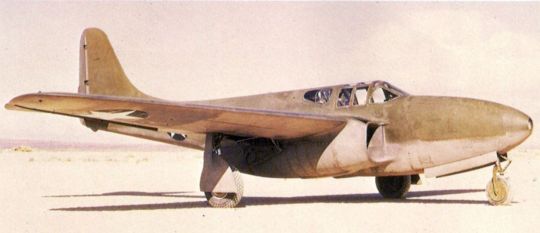
-A U.S. Army Air Forces Bell XP-59A Airacomet (s/n 42-108784) at Muroc Dry Lake, California. | Photo: USAAF
FLIGHTLINE: 184 - BELL P-59 AIRACOMET
The XP-59 was the first production jet fighter for the US, but the subpar performance saw the few aircraft completed relegated to training.
Development of the P-59 can be traced back to April 1941, when Major General Hap Arnold of the USAAC attended a demonstration of the Gloster E.28/39, the first British jet aircraft. Seeing the potential of the technology, Arnold took copies of the plans for the Power Jets W.1 engine, and arranged for an engine to be flow to the US along with a team or Power Jets engineers as well as plans for the uprated W.2B/23. General Electric was offered the license to produce the engine in the US, where it was known as the GE I-A, while Bell Aircraft was granted a contract to build a fighter to use it. In order to disguise the nature of the program, the new aircraft was given the designation P-59A, making it appear to be a development of the unrelated XP-59 project developed for the R-40C competition. Three prototypes were authorized under the contract, and the design of the new plane was finalized on 9 January 1942, after which construction began.

-Orthograph of the P-59A. | Illustration: Kaboldy
DESIGN AND SPECS
The P-59A was of all-metal stressed skin semi-monocoque construction, with mid-mounted, straight wings. The GE J31 engines, developments of the I-A, were housed in nacelles under the wings and close to the fuselage. The single-place, pressurized cockpit was positioned above the leading edge of the wing, behind the armaments stored in the nose. The prototypes were armed with two 37mm M10 autocannon with 44 rounds each. Self-sealing fuel tanks within the wings, two per side, carried 290gal of fuel. The P-59s were fitted with electrically-actuated tricycle landing gear, an advanced feature for the time. The plane was 38 feet long, with a wingspan of 45' 6", and a height of 12 feet. Empty they weighed 8,165lb, while at max TO the weight increased to 13,700lbs. Maximum speed was a little over 400mph, while cruise was 375mph. Combat range was 375 miles, and the service ceiling was 46,000 feet. The P-59 was not an interceptor, as the time to 30,000 was a positively sedate fifteen and a half minutes.
The prototypes were constructed at a factory formerly occupied by Pierce-Arrow, though none of the elevators at the facility could accommodate the completed aircraft, and a wall needed to be removed to extract the aircraft. The first XP-59A was shipped by train to Muroc Army Air Field (now Edwards AFB) on 12 September 1942, and the first (accidental) flight was on 1 October during high-speed taxi tests, with the official maiden flight occurring the next day. During shipping and testing, the XP-59s wore a false propeller to disguise their true nature. By March 1943, the second prototype had joined the first, and after rains flooded Muroc it was towed, on a public road, to Hawes Field at nearby Victorville Army Airfield to continue test flights.

-An XP-59A prototype, under a tarp and with a false propeller affixed to its nose, likely at either Muroc or Victorville AAF. | Photo: USAAF
Even before the first flight of the XP-59, the Army ordered an additional 13 pre-production models, designated YP-59A, for familiarization and training. This was followed in July 1943 by an order for 100 operational model P-59A, which received the name Airacomet in a poll of Bell employees. The A model would be equipped with three .50cal M2 Browning machine guns as well as a single M10 autocannon, and would also differ from the XP and YP-59 in having improved model J31 engines, as well as squared off wingtips and horizontal stabilizers. A further 80 P-59B were ordered as well, which had two additional self-sealing fuel tanks, one in each outer wing, and provisions for two 1,590gal drop tanks.
FLIGHT TESTING

-An XP-59A with the short-lived red-outlined roundel, dating the photo to between June and September 1943. | Photo: USAAF
Deliveries of the YP-59 began in July 1943, and one aircraft was bailed to the RAF in exchange for a Gloster Meteor. British pilots were not enamored with the Bell jet, finding it underpowered and unstable compared to their usual mounts. Two other YP-59s were lent to the US Navy as YF2L-1s, but the Navy judged them to be unsuitable for carrier operations. Flight tests of the XP and YP-59s continued, but, as with the Navy and RAF, the AAF found them slow and unstable, with a tendency to "snake" at speeds over 290mph. The J31s had poor reliability and throttle response (as was typical of first generation jets), and the thrust produced was below expectations. Combat trials against P-38 Lightnings and P-47 Thunderbolts found the older prop-driven planes were faster and more maneuverable.

-The first production P-59A in formation with a P-63 Kingcobra. | Photo: USAAF
The results of these trials cooled the USAAF's interest in the P-59, and the order for P-59As was cut to 50 machines on 10 October '44, with the P-59B order cut to just 30 aircraft. Bell ceased production of the Airacomet at the end of 1944 in order to focus on P-63 Kingcobra for the Soviet Air Force, with only 20 A models and 30 B models completed. Most of the P-59Bs were assigned to the 412th Fighter Group at Muroc for familiarization of pilots and ground crews, while three aircraft were transferred to the Navy for further flight trials and training. With the end of WWII and more advanced aircraft like the Lockheed P-80 now flying, the P-59 was relegated to ground tests, and by June of 1948 the Status Prefix Z, indicating an obsolete aircraft, had been applied to the P-59, functionally ending its career.
SURVIVING AIRCRAFT
Of the 66 Airacomets built, only 6 are known to survive: a single XP-59 is on display at the National Air and Space Museum in Washington DC, while the only P-59A is located at the March Field Air Museum in Riverside, California. Three P-59Bs survive, one at the National Museum of the USAF in Dayton, another mounted on a pole outside Edwards AFB, and the last at Pioneer Village in Minden, Nebraska. A YP-59A has been undergoing restoration to flying condition at the Planes of Fame Museum in California for the last decade.

-The NMUSAF's P-59B, outside during a reorganization of the hangar in 2007. | Photo: NMUSAF
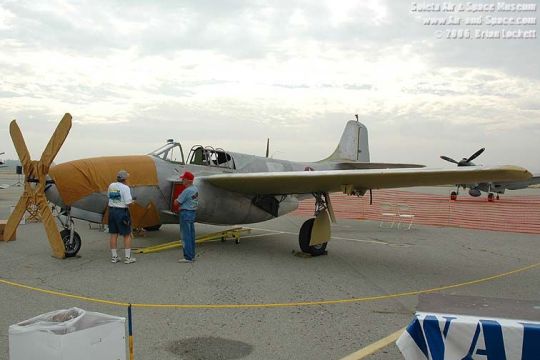
-The YP-59A at 2006 Warbird Airshow. As was done more than 60 year previously, a false propeller was fitted to the plane. | Photo: Brian Lockett
#aircraft#aviation#avgeek#airplanes#airplane#aviation history#usaf#usaaf#wwii aircraft#wwii history#ww2 aircraft#ww2#ww2 jets#early jet#bell aircraft#general electric
102 notes
·
View notes